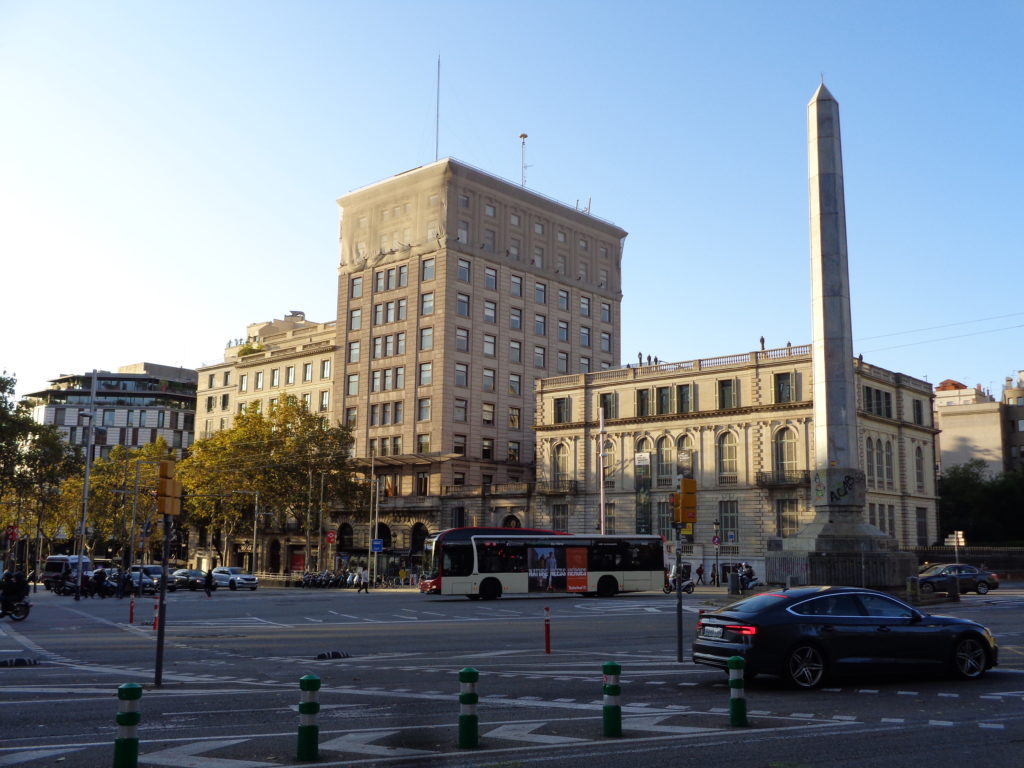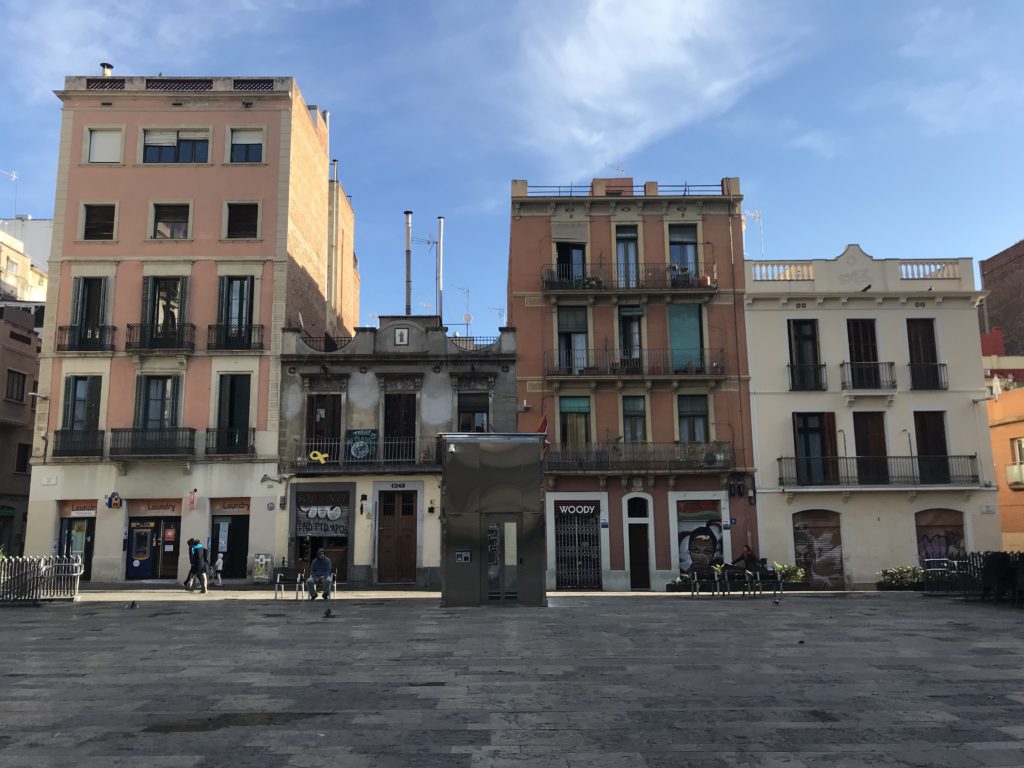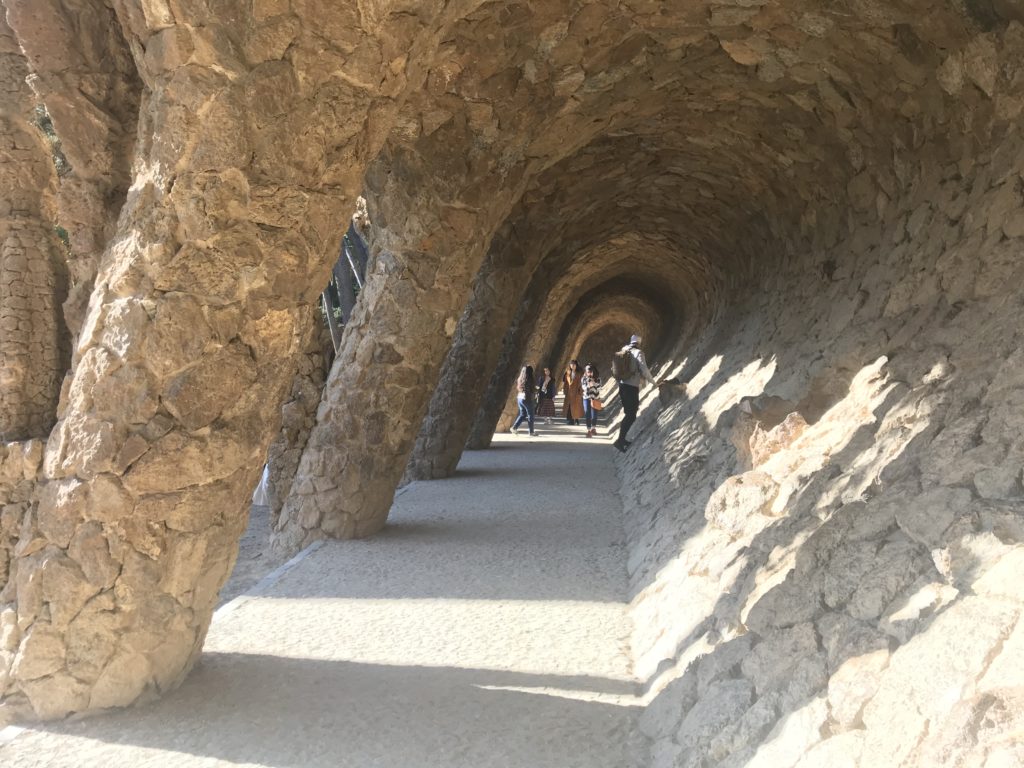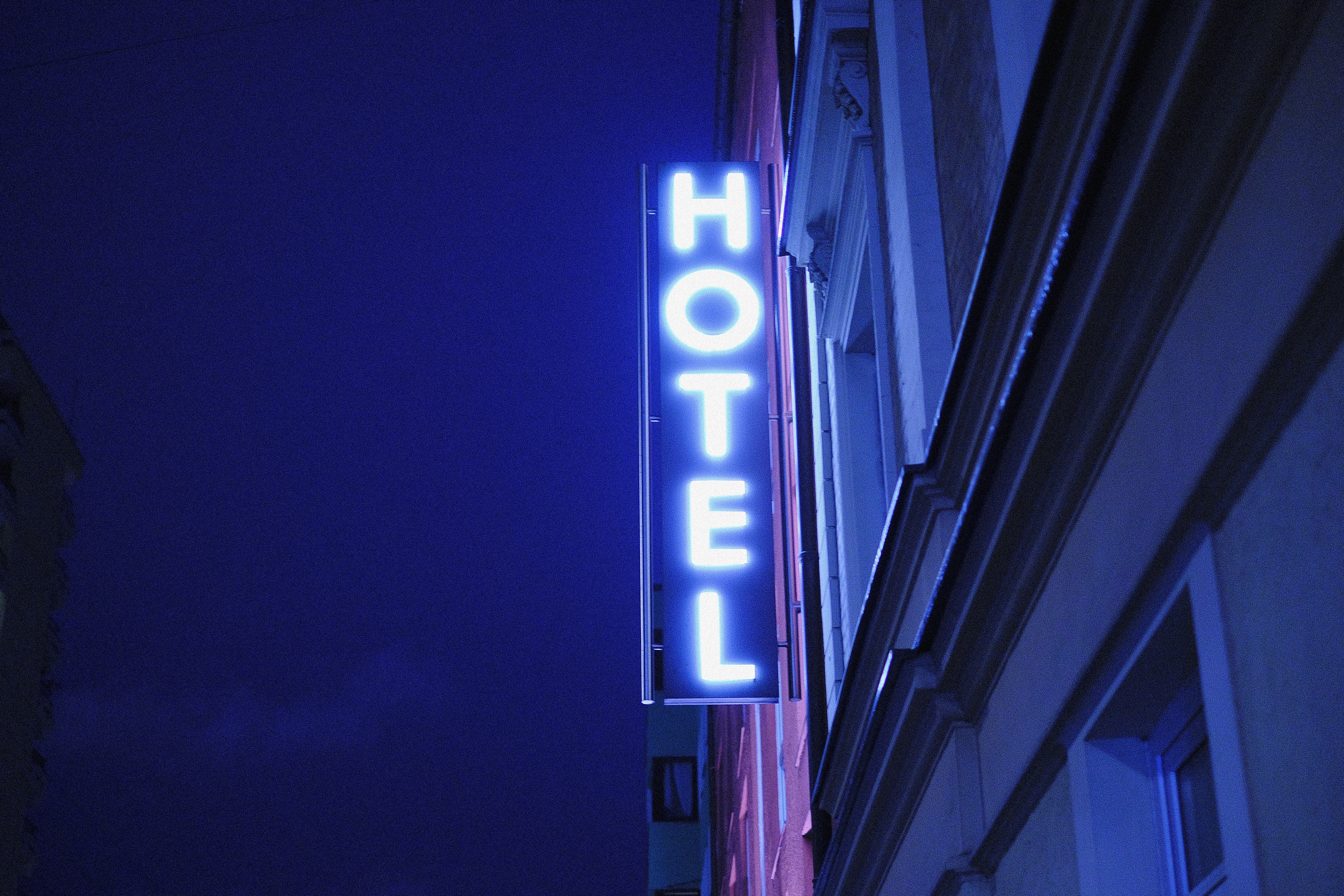Author’s note: I write this post in a different style. Each time I read the occasional travel piece written in the present tense it intrigues me. It feels so much more personal. The choice here is a conscious one, for better or for worse.
The announcement over the PA is my final cue that it might be time to open the window shade. Sliding the plastic upward, a view of Barcelona welcomes me, stretching from the Mediterranean coast to the hills. I can pick out only a couple landmarks amid the urban scene before me. What a chance to explore lovely city! The elation hits, mixed with just a twinge of sadness. It is such a long trip for such a short stay.
But that is the way things must be this time around. I’ll have just 40 hours to enjoy Barcelona before heading back to the airport for my return to the U.S. It is the return leg of an error fare I booked. Little did I know that this whirlwind trip wouldn’t provide me the needed boost I anticipated for Delta status.
Touching down at Barcelona El Prat Airport, the Airbus A320 taxies toward Terminal 1. Although my previous trip through BCN was a few weeks prior, I can’t shake the feeling that I was just here. Before long I’m stuffed in the back of the A1 airport bus headed directly to Plaza Catalunya. It’s an easy option, although slightly more costly than the subway or train. The fact the bus runs above ground is an obvious benefit, entirely worth the difference in price. It gives me my first view of the city.
Benvingut a Barcelona!
Steeping off the bus, I’m finally able to take in Barcelona with all my senses. The November chill is noticeable, a marked difference from the warmth I experienced just a few weeks prior. Meandering across Plaza Catalunya, the heart of the city, I make my way to the Hotel Indigo. The IHG property offers a good location and, in this case, an affordable price.
A shower is first on the agenda. It’s been a long day of flying, but there are still a few hours to enjoy the city. Evenings out in Spain can last into the wee hours, although this isn’t a challenge I’ll personally take. Dinner and bit of exploration are sufficient.
I make a brief detour on the way to the Poble-Sec neighborhood where dinner awaits. It would be a shame to pass up Casa Batlló when it is this close and still daylight. The famous Gaudi building is just a couple blocks from my hotel. The edifice truly is amazing.
We shall see if I shell out the €25 entry fee later. I’m not even sure I’ll be able to stuff a tour in among my other plans. My next stop is La Tasqueta de Blai, a small establishment in Poble Sec, intent on making pintxos my first meal.
Delicious Pintxos Dinner
Located along the pedestrian street, La Tasqueta de Blai looks modest on the outside. But don’t let that fool you! The pintxos (Spanish: pinchos) are incredibly good. The reviews I’d read state that the place is first rate, and they don’t lie!
Pintxos are traditional to northern Spain. The basic idea is essentially to pile a small slice of bread with various toppings, spreads, and the like and hold it all together with a skewer. They are a popular staple in bars. The assortment offered at La Tasqueta de Blai is extensive, and the mix of smells intoxicating.
Pintxos are as much for the tastebuds as they are for the other senses. I’m in love instantly. The pinxto towering with pepper, egg, and sweet caramelized onion on top of a red sauce base is decidedly the best. But the others aren’t far behind.
Going back for more is a must. Although I could likely devour multiple plates, I make myself stop at a half dozen. I’m not sure my wallet can handle what delights the eyes, as you pay by the skewer.
But the damage isn’t that bad. My entire dinner of six pintxos and a glass of wine sets me back a mere €11.10. You can’t ask for a more perfect match-up. Delicious food at an affordable price!
The Magic Fountain of Montjuic
Dinner is early, far earlier than the typical Spanish schedule. La Tasqueta de Blai is fairly lively, but more than half of the clientele are tourists. The rest of the pedestrian area of Poble Sec is fairly quiet. With an hour to kill, I meander the streets, slowly winding my way up the hill to the MNAC.
It’s not my intention to visit the museum. Nor could I, seeing it is closed. I’m here for the view. Looking down the hill, I see the Plaza España laid out below. It’s not the nicest of evenings, yet it is a lovely view. In the middle, halfway down the hill, under the columns, is the Magic Fountain of Montjuic, my next destination.
It’s a popular place to visit during after dusk in Barcelona. Even on this chilly November evening, the magic fountain attracts quite a crowd. I’m surprised at how many people have already staked out their territory on the steps above the fountain. Looks like I’m a little late, even with 30 minutes to kill.
I people watch to pass the time, staring out across the crowd, and back up the hill toward the museum. More people are on their way up. The anticipation of the magic fountain show grows and the crowd slowly swells. As it finally erupts into various colors and patterns, everyone moves forward, as close as they can get.
Timed with accompanying music, the fountain is mesmerizing to watch. The introduction lasts just a few minutes before a brief pause, after which the fountain and lights rhythmically dance to various pop songs. It’s certainly enjoyable, but I decide to split before the full hour passes. The exhaustion is creeping up on me and the desire for sleep calls me back to the Hotel Indigo.
Unwinding in a comfortable seat at the lobby bar, I plan out my next day. My musts are exploring the Catalan neighborhood of La Gràcia, visiting Park Güell, and finding a fantastic tapas bar. There will be more than enough time for all of that, plus much more.
Gaudi and La Gràcia
I sleep fitfully, unable to rest well due to the jet lag. At 5:00 AM I throw in the towel and work until the morning light creeps into my room. It’s time for a coffee and juice. Breakfast will have to wait. The La Gracia restaurant I selected doesn’t open until 8:30 AM.
Wandering Eixample for a while, I finally make my way down the street again toward Casa Batlló. Anton Gaudi’s masterpiece is truly unlike anything I’ve seen, and would have certainly been unprecedented in his era.
Down the street is a second edifice, Casa Mila. I don’t plan to tour either. The architecture is more than enough to satisfy. Yet it makes one intensely curious about the man who designed them.
Crossing into La Gràcia, I weave my way through the narrow streets. My reading points to La Gracia as one of the more Catalan neighborhoods in Barcelona. Originally its own town, La Gracia has been swallowed up by the city over the decades.
I head in the direction of La Pubilla, a hole-in-the-wall Catalan establishment. It’s the perfect spot for my first breakfast in Barcelona.
A Taste of Catalonia
La Pubilla is quiet, almost too quiet. I’d arrived minutes after opening, and aside from another fellow having a coffee at the bar, there isn’t anyone else in sight. But this doesn’t last. The restaurant fills completely over the next 15 minutes. I nurse a tiny espresso, regretting my decision to let the waitress bring me a cafe solo instead of con leche.
Espresso is strong, but I silently wonder if I should have chosen something even stronger. Most other patrons seem to have no qualms starting the day with a glass of wine or beer.
The pancetta sandwich I order is delicious, served with ham and cheese on an excellent baguette. One must get used to eating pork on a regular basis. This isn’t just a feature of Barcelona, but of all Spain. It’s probably the biggest staple of the Iberian Peninsula.
Breakfast sets me back €9.90, far more affordable than the €30 demanded by the Hotel Indigo buffet. And I’d much rather have the local experience. I’m amused when the cashier asks if I’m from Italy. Apparently my American accent is more masked than expected. I make a mental note to tell my daughter, a native Spanish-speaker. She ribs me about my accent.
My favorite way to see a city, especially the first day, is on foot, and I make no exception to this rule as I continue to explore Barcelona. If anything, it’s even more critical. I enjoy my walk through the rest of La Gracia, stopping at the plaza before slowly meandering up the hill toward Park Güell.
Park Güell
Although the walk is nearly two kilometers, I hardly notice. There’s so much to take in. The prize at the end is another masterpiece of Catalan architect Antoni Gaudí.
Named for his friend, Eusebi Güell, the park sits in an enviable location, atop a hill with views of the Barcelona plain below and sea beyond. Like Gaudí’s other works, the design of the structures is flowing, and the surfaces are decorative. I pay the entry fee to visit the monument zone, heading down into the crowds. It’s a crisp Friday morning in the autumn. I can only imagine how this place must be during peak summer tourism.
The trencadís, small, irregular, often recycled tile pieces, cover nearly everything. The artistry of this “secondhand” use is truly remarkable.
Heading up to the top terrace, I’m presented with a fantastic view of the gates of Park Güell and Barcelona in the distance. It’s magnificent to be here, if just for little more than a day.
The walk down the hill winds along the Pòrtic de la Bugadera, the Portico of the Washerwoman (in Catalan). The elaborate retaining-wall-turned-pathway is named for the single sculpted column, although most of the supports do not have any sort of design. I snap the best photo I can of the structure. It is a popular place for pictures.
The ongoing renovation doesn’t help the business at this UNESCO world heritage site. The crowds are too much. Satisfied with my close-up view of Gaudí’s interesting design, I exit into greater Park Güell.
Gaudí’s Residence
There is still more to see outside the Monument Zone. Up the hill, past one his beautiful viaducts is the home Gaudí lived in for two decades. The view from the house is even more impressive, as it overlooks both Park Güell and Barcelona. A combo ticket for the house and La Sagrada Familia costs €27, but it is well worth the price.
Gaudí’s residence contains some of his other design pieces, mostly simple, yet wonderfully artistic furniture. Some offer an amount of symmetry like these chairs. Others don’t in the slightest.
Masked under the elaborate, nature-inspired art is an austere man. Gaudí was deeply religious, holding to his catholic convictions throughout his life. The simplicity and functionality of his room exemplifies his inner workings.
The residence is small, but I enjoy my self-guided tour immensely. My aching legs are already reminding me how much I need to exercise back at home. I force myself to keep moving. There is so much to see and so little time.
La Sagrada Familia
It’s a steep downhill walk to get to the metro station, but Vallcarca is the closest. I’m whisked back to my hotel where I hurriedly pack and check out. I knew I was pushing myself when I picked a 12:45 PM visit to La Sagrada Familia. Instead of walking, like I’d planned, I find myself hailing a taxi. My legs thank me while, my wallet’s chiding notwithstanding.
But I cannot be late. La Sagrada Familia is one of Barcelona’s most iconic sights. A lifelong dream of Gaudí, his design was so forward thinking that only a fraction of the structure was completed before he died. It’s completion is currently planned for 2026, the hundredth anniversary of Gaudí’s death.
The highest tower will one day be a colossal 172 meters, surpassing the Ulm Minster in Germany, which currently holds the title of the tallest church building. I pick up an audio tour handset and head up the stairs toward the entrance.
The ornamentation above the entrance tells the story of Jesus’ life. I’ve admired a good number of churches, but nothing has been as unique as La Sagrada Familia. It’s in a league of its own.
If the exterior is stunning, the interior is absolutely jaw-dropping. With central pillars reaching up like trees toward the heavens, the construction is unlike anything I’ve ever seen. It’s breathtakingly grand.
With colors shifting from warm to cool, the stained glass is extraordinary as well. Where many churches have stained glass depicting scenes, the beauty of La Sagrada Familia is in the intense colors themselves.
I’ve never been so in awe of a building in my life. If there is one place you must visit in Barcelona, it is this magnificent church. I may just need to return in 2026 for its completion. There are many buildings that I’ve visited that I greatly admire, but few evoke a similar sense of awe.
Barceloneta and the Old Town
I spend an hour and a quarter, start to finish, visiting La Sagrada Familia. However, it’s well into the afternoon, and I’m getting hungry. Spanish lunchtime is atrociously late for the typical American. Let’s hope the next stop is worth pushing off lunch until 2:30 PM.
Heading back into the sunlight from the metro station, I’m greeted by La Barcelonta. I find it the oddest neighborhoods in the city that I’ve visited so far. The narrow buildings and regular streets are a contrast to the more typical city blocks in Eixample. My destination: La Cova Fumava, a hole-in-the-wall tapas bar.
At 2:30 PM, the place is packed. I’m lucky to snag a spot at the bar. A table would have been impossible to obtain before they started winding down, as there was a waiting list scratched onto a tiny notepad in the proprietor’s pocket. He invites me to the end of the bar, vacated minutes after I arrive.
There is some debate as to where the term tapa comes from for the small plates of food that are served. But the idea has been exported all over the world from Spain. I’ve been to only a couple other tapas bars, but neither had this feel. It’s loud and busy, and smells of fried food and garlic.
I wait to place my order which is likely a mistake. From the looks of it, you need to flag the nearest staff down and simply place your request. I make my selections based on what I see around me: pan con tomate, sardinas, and (of course) a classic bomba. A small pitcher of white wine washes everything down.
The plates come as they are ready. I’m amazed that the staff can remember so easily where things go, with parts of multiple patrons orders being whisked to them as they come out of the kitchen. The orders scratched in pencil on the bar simply seem to be a tab of what you’ve eaten, not a way of keeping orders straight. I consider ordering more, but the three delicious plates are more than enough. The damage is minimal at €11.40. Don’t pull out your wallet early to pay. Settle up only when you’re sure you’ve had enough.
La Cova Fumada is quickly closing shop by the time I’m not, so I bid the proprietor goodbye and wind through the streets of Barceloneta once more. It’s an interesting neighborhood. The whole area seems planned, which is a stark contrast from the Old City, where I’m headed next.
Exploring the Ciutat Vella
Crossing over the main boulevard, I make my way into the oldest part of Barcelona. The streets are narrow, and many are pedestrianized. It reminds me a bit of our tour of Nice, France, the 4 and 5-story buildings towering above you on either side as you wind your way along.
I meander for a while, enjoying the architecture and quiet. The latter is surprising. I would have expected this part of the city to be quite alive, as it is one of the tourist areas. Checking back in the evening might be in order, but I’ll likely be too exhausted by then to want to return.
I make my way to two churches. The first is the Basilica de Santa Maria del Mar. The second is the Barcelona Cathedral, in the Gothic Quarter. It’s beautiful and impressive, but not nearly as impressive as La Sagrada Familia. In a way I find this sad, that something so new can overshadow something with so much history.
I’m not here to stay for long. My tour through the old city is simply to enjoy the architectures and a few of the highlights. It would have been lovely to take a full walking tour, something I’m keen on when traveling. But time simply doesn’t allow for it. Soon enough I find myself on La Rambla, headed back toward Eixample toward the hotel.
The original plan was to walk the whole way back, but my legs are aching by this point. A metro ride will get me back sooner, and I can put my feet up for an hour. Heading down to the Liceu station, I’m accosted by a Chinese couple. Through broken English and Spanish, I finally understand that they want to buy a pack of metro tickets. It’s an easy task, but one that would be more than a bit difficult if you cannot read Spanish or English.
The image of the gentleman bowing slightly, hands together, thanking me with a thickly accented “muchas gracias” is something I will not soon forget. The whole incident caused me to consider just how privileged it is to be an English-speaking traveler.
Return to Montjuic
My hour of R&R at the hotel may be an mistake. With tired muscles and fighting jet lag, I come close to throwing in the towel. But I’m here across the world, and for precious little time. I push myself back onto my feet for a couple more hours out. There are still a few stops left on the agenda: a market, a walk through Montjuic, and more pintxos to finish off the night.
The public Mercat d’Hostafrancs is a fun, quick stop. I wander the aisles of stalls for maybe roughly 15 minutes, enjoying the eclectic mix of foodstuffs offered by various vendors. There is salted fish and other seafood, a variety of cheese, and a mix of olives and dried fruit. But all this is dominated by meat vendors. I’ve never seen this much cured ham in my life. Jamón from the pata negra (black-footed Iberian pigs) is the pinnacle of Spain’s pork products. I consider buying a small amount, but with dinner just around the corner I decide to pass.
The light in the sky is fast disappearing, so I hurry to Plaza España for a daytime view of the Magic Fountain and hilltop museum. There are no crowds, but this is still a couple hours before the show. From there it is another 10 minutes back to El Poble-Sec.
Pintxos Once Again
Given how amazing the pintxos were the previous evening, I nearly head back to La Tasqueta de Blai. But there are plenty of other pintxos restaurants in Poble Sec, and I figured it’s worth giving another a try. I worry that the initial experience set the bar too high and all future pinxtos may be less than satisfactory.
La Taberna Blai Tonight seems a reasonable choice. It’s even more affordable than my dinner the previous evening, as I walk out having dined for a mere €8.80. The pintxos are good, but the quality and flavor isn’t quite up to the same standard as at La Tasqueta de Blai. I did set myself up for a bit of disappointment. Note to self: never eat your best food on the first night.
It’s barely 7:00 PM, but I’ve been on my feet for over 11 hours at this point. Heading back to the Alexandra Barcelona Hotel seems the wise choice. I enjoy a drink at the lobby bar and then hit the sack. There will be just enough time the next morning for a quick stroll down La Rambla before I rush back to the airport.
The Final Hours
My day begins early again, as sleep is impossible after about 3:00 AM. I work for a couple hours before heading downstairs, hitting the breakfast buffet right when they open at 7:00 AM. By the time I leave, it’s light out, but still before sunrise. This is one of the downsides to visiting outside of summer. Spain should really be using Greenwich Mean Time, but they’ve pegged themselves to the continental schedule. Days begin late and end late. Maybe this helps explain the odd Spanish schedule.
The metro takes me to Drassanes, the station nearest the Mediterranean, at the end of La Rambla. I head to the water’s edge before turning around and walking the tree-lined pedestrian thoroughfare. There’s not much life this early on a Saturday. I almost prefer it this way, able to peacefully admire the city’s architecture one final time.
I make a quick detour into Mercat St. Josep La Boqueria. It’s still coming to life at a little after 8:00 AM. Merchants are arranging their colorful foodstuffs, ranging from stacks of bright fruit and juice to eclectic mixes of seafood.
Of course there are also the staple xarcuteries with all the cheese and cured ham you could ever want. I didn’t even want to ask how much one of the whole Iberian hams sells for. They can be ridiculously pricey, demanding anywhere from $200 to $800 (or more) a piece.
Wishing I had another hour won’t do any good at this point. I must press on unless I want to risk arriving too late to the airport. The rest of Barcelona will have to wait for another trip, which I am certain I’ll make after this experience.
Following La Rambla, I pass by Plaça Catalunya once again. My trip has brought me full circle.
Adéu, Barcelona
Sitting on the train heading back to Barcelona El Prat International Airport, I reflect on my crazy whirlwind trip. I almost didn’t take this return leg of the Alitalia business class trip error fare I booked. Yet now I am so glad I did. The whirlwind 40 hours I had to explore did not disappoint. The capital of Caalunya is lovely, just as lovely as I’d hoped it would be.
Bareclona, I’ll be back. It’s possible I wait until 2026 when La Sagrada Familia will finally be completed. But maybe I’ll make it back before then. Until then, adéu.






















































